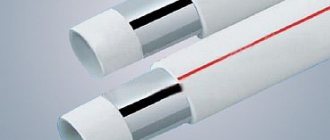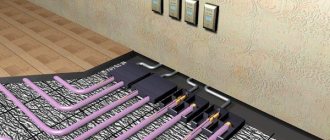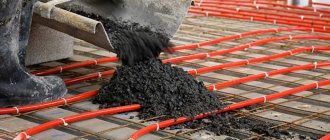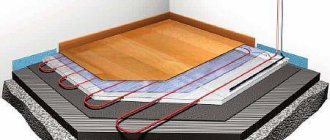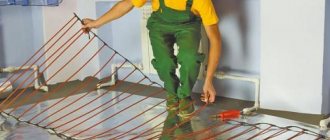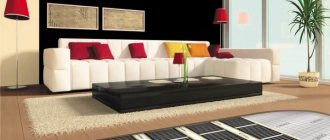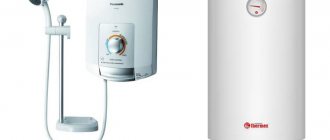Problems with heating residential premises during the cold period are the most pressing for the bulk of the population of our cities. There is no hope for a qualitative improvement in centralized heating. The process of equipping households with autonomous heating systems is going quite slowly. If we talk about city apartments in old buildings, then the situation here generally looks critical. The desire of residents to install additional heating sources in their apartments is met with prohibitions from regulatory organizations.
Despite the illegality of installation, many residents of apartment buildings are trying to install warm floors in their apartments, a heating system that is recognized as the most effective today. Just the desire to install heated floors in your apartment is not enough. There are a number of technological problems that will have to be solved by those who want to improve the comfort in their own home.
The installation of the heating pipe itself does not raise any special questions. It is important to follow the installation technology here. Another thing is the heating source (heating device). Gas boilers, central heating and hot water supply systems, all these connection options have practical implementation. Against this background, it will be interesting to consider from a technological point of view the possibility of connecting a heated floor from a home boiler.
Is it possible to connect a heated floor to a boiler or not?
When constructing water-heating floors, owners of apartments or private houses should:
- make a structure that will warm the air in the room to the required level;
- choose a profitable option in terms of installation and operation, which will be inexpensive.
First, we suggest that you learn the structure and operating principle of a water heated floor and the possibilities of combining the system with various devices (radiators, three- and two-way valves, etc.)
Gas or electric boilers are used to heat the coolant. More often, gas-fired boilers are installed in private buildings. It will not be possible to install such equipment in apartments with central heating.
In addition, to connect to a common heating system, you must obtain special permission. Therefore, there is a need to find an alternative method - this is the installation of an electric boiler.

Boiler is a device for heating water from electricity for domestic purposes. But it is worth noting that it was not originally intended to heat liquid for underfloor heating. Therefore, this will be an additional load for him, as a result of which the water heater may fail.
However, it is still possible to power the floor from a boiler, but it will not be possible to heat large areas using this method. This option is ideal only for the bathroom or toilet.
For your information! Correctly calculating the load on the electric heater is important.
An attempt to connect underfloor heating to an indirectly heated domestic water heater. Rationale
Calculation and design of a heating system for any of us represents the implementation of a task in which there must be two answers - saving money and achieving the desired result. In many cases, we try to make it easier for ourselves, to make heating in our own apartment very efficient, while spending little money. Actually, this reason forces us to look for other options for connecting heating circuits. The idea of using a storage water heater for this purpose is not considered exemplary, but such an option has the right to life.
The main difficulty is that the operation of a storage water heater in such an embodiment will be considered an inappropriate use, which naturally can lead to premature failure of the heating device. Home storage water heaters are designed to provide home residents with hot water at home. Placing an additional load on an electrical device means fundamentally changing the manufacturability of the device.

The decision to use an electric storage water heater as a source of heating the heat carrier can only be driven by an urgent need and desire to quickly get rid of the problem with heating a home.
Types of boilers
A water heater is an electric boiler equipped with a tank in which heated liquid accumulates. For domestic purposes, designs up to 100 liters are used, and for industrial purposes up to 300 liters. An industrial type is recommended for installing floor heating.
By design, boilers are either instantaneous or storage.
Flow-through
Flow-through - a compact tank with a square-shaped ten, which is connected to a cold water supply. When turned on, the water heats up almost immediately. The power of such heaters is 6 - 10 kW, so they place a large load on the electrical network.
A tankless water heater is not suitable for heated floors.
Cumulative
A storage heater is a container with two casings, between which there is a protective layer of heat-insulating material (polyurethane foam). The outside body is enameled steel.
The inside of the flask has a coating of glass enamel; the process of its application is spraying, which allows you to obtain a smooth surface on which scale does not form. In addition, the enamel does not react to salts present in water and is not subject to corrosion.
Some models have an internal coating not of glass enamel, but of glass porcelain - the surface is of high quality, but if it is exposed to high temperatures for a long time, cracks can form. However, manufacturers guarantee that the device will operate uninterruptedly for at least 10 years.
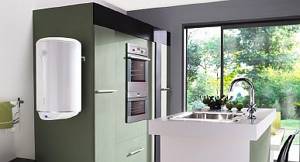
Another type of coating that is used for boilers is stainless steel with titanium, which can withstand high temperatures. A water heater with such a coating will last for many years.
A heating element (in the form of a tubular heater) is placed inside the container; it heats the coolant. The ten is placed in a metal pipe, this protects it from scale. In addition, the flask contains a magnetic anode - a rod with positively charged particles that neutralize the negative charge.
This helps reduce corrosion formations. The rod needs periodic replacement, as it wears out quite quickly. The water heater is equipped with pipes through which cold water flows in and hot water comes out.
For your information! Today, models of electric water heaters with a volume of 250 - 300 liters have appeared on the market, which were specially designed for use in heating systems. Their difference is in the location and cross-sectional size of the supply and return openings.
The standard power of storage models is 1.5 - 3 kW. The device is similar to a thermos; the water is heated and then slowly cooled, thereby maintaining a high temperature for a long time.
In addition, these types have a thermostat, which allows you to set the heating temperature required for heated floors. And when the required temperature level is reached, the boiler automatically turns off, which contributes to rational energy consumption.
In shape, boilers can be horizontal or vertical. The vertical design is recommended for arranging heating floors.
It is important to know! To heat 15 liters of water to 60 degrees, you will need a heater with a power of 1 kW, heating time is 1 hour.
A 100 liter tank will reach this level in 3 hours, with a power of 3 kW.
The best indirect heating boilers for 200-400 l
Boilers with a tank of more than 200 liters are used in multi-storey country cottages, offices and enterprises to provide sanitary water.
ACV Smart Line SLE 300
5
★★★★★ editorial assessment
100% of buyers recommend this product
The boiler has a spacious stainless steel tank with a capacity of 293 liters. The body is made of polypropylene, which is scratch-resistant and gives it an original appearance.
And polyurethane foam thermal insulation ensures long-term preservation of the temperature of heated water.
The water heater is equipped with an electric heating element, thermostat, thermometer and recirculation system. It has overheating protection and self-cleaning technology against scale.
Advantages:
- Heats up in 20 minutes;
- Electric heating element;
- Thermostat;
- Self-cleaning from scale;
- Scratch-resistant housing.
Flaws:
Expensive.
The SLE 300 boiler from ACV is a modern, highly efficient equipment that is suitable for year-round provision of hot water.
Thermex ER 300V (combi)
4.9
★★★★★ editorial assessment
95% of buyers recommend this product
The ER 300V boiler from Thermex has a classic round shape. It is designed to produce and maintain hot water temperatures up to 75 °C.
The water heater is equipped with a 300 liter tank with a unique bioglass porcelain coating, which ensures a long service life.
The standard package includes an electric heating element, which increases efficiency and ensures autonomy of the water heater.
The efficiency and ease of use of the boiler is increased by the presence of a thermostat, thermometer and recirculation. And protection is guaranteed by a safety valve and an overheating protection system.
Advantages:
- Heavy-duty tank coating;
- Electric heating element;
- Thermostat and thermometer;
- Safety valve;
- Recycle.
Flaws:
Heavy weight.
The performance of the ER 300V boiler from Thermex is sufficient for technical water supply to a family of 6 or more people, as well as for medium-sized production.
Drazice OKC 300 NTRR/BP
4.9
★★★★★ editorial assessment
90% of buyers recommend this product
The OKC 300 series NTRR/BP boiler from Drazice is a reliable piece of equipment with high efficiency. It is designed for heating non-edible water.
The boiler tank is designed for 295 liters of liquid. Two spiral heat exchangers provide rapid heating of water up to 90 degrees. And the magnesium anode protects the surface of the enamel-coated container from corrosion.
The water heater has a working thermostat, a thermometer and a water heating alarm. There is also a service hatch for easy maintenance. Additionally, you can connect an electric heating element to it.
Advantages:
- Two heat exchangers;
- High heating temperature;
- Thermostat and thermometer;
- Service hatch.
Flaws:
Not suitable for drinking water.
Boiler OKC 300 NTRR/BP from Drazice is an ideal solution for organizing hot water supply in places where there is no centralized supply of hot water.
Operating principle of a water heater
The operating principle of an electric boiler is mixing cold and hot coolant. Heated water rises to the top, and cold water is located below, where it is heated.
The operating process of the water heater is as follows:
- The storage tank is filled with water through a special pipe. The inlet is equipped with a safety valve; it holds the liquid and does not allow it to flow back.
- The thermostat sets the required temperature, but not more than 80 degrees.
- The heater turns on automatically and water heating begins.
- The hot liquid rises upward and exits through the intake tube located on top of the tank.
- The coolant moves through the intake pipe into the floor pipeline.
Characteristics of gas models
Modern modifications of gas boilers must be equipped with electronic controls that regulate temperature parameters, ensuring the safe operation of the system.
In order for the automation and circular pump for a warm water floor to work in the event of a power outage, it is advisable to stock up on a local source. Car batteries will provide several hours of operation. In situations where there is a risk of frequent power outages for several days, you will have to purchase a diesel generator.
The principle of operation of the boiler is based on the circulation of the coolant through the exchanger, during which it is heated by the flue gases produced when the fuel burns. During the transfer of thermal energy, the gases are cooled, and at a certain temperature condensation is formed, causing the appearance of additional heat. This feature significantly increases the efficiency of heating equipment.
Gas boilers function flawlessly under conditions of uninterrupted gas supply, without requiring special routine maintenance techniques. In designs that provide an electronic mechanism for igniting the boiler, the operation of the burner is regulated in accordance with the specified temperature values with the removal of all harmful combustion products through forced ventilation. Boilers with piezo ignition, operating automatically, also stop the flow of gas if the flame goes out, but combustion is restored manually.
Which boiler to choose?
For the construction of warm water floors, the model of a flow-through electric boiler is practically not suitable. The main disadvantage is the significant energy consumption.
The only suitable option for heated floors is a storage water heater. When choosing the type of heater, attention should be paid to the power of the equipment; this determines how intensively and quickly the coolant is heated, as well as its volume.
For your information! Devices with a power of 6 - 10 kW are specially designed for installation in conjunction with heating systems. Their main disadvantage is their high electricity consumption.
When calculating the power of an electrical appliance, you should start from the fact that to heat an area of 10 square meters you need a water heater with a power of 1 kW, so a household boiler model is not suitable for heated floors. It can only be used for small rooms - a bath or toilet.
The second point that you need to pay attention to when purchasing is the volume of the tank. The greater the amount of hot coolant received, the less often the water heater will be turned on periodically, in order to help save resources.
Criteria for choosing a boiler for autonomous heating of a private house
When choosing the type of boiler for heating, there are no alternatives only if gas is supplied to the house; it is the cheapest type of fuel and, in comparison with other sources (electricity is not considered), has a number of operational advantages - it does not require space for storing reserves, highlight There are fewer combustion products released into the environment and does not pollute the chimney system as intensively.
The main parameters that people pay attention to when choosing a boiler are:
- Unit power: directly related to the area of heated premises and temperature conditions, which are usually chosen based on building codes and GOSTs.
- Number of circuits: if the house does not have hot water supply, it is more practical to choose a dual-circuit model that can heat water.
- Location: usually the unit is installed downstairs in the basement on the floor; there are also hanging options for small houses.
- Material of manufacture of the unit and heat exchanger: cast iron, stainless steel, copper.
- Type of combustion chamber according to the method of supplying air to the firebox: open or closed.
- Availability of automatic control and monitoring systems, possibility of programming operating modes.
- The ability of the boiler to work with alternative fuels: relevant for liquid fuel modifications.
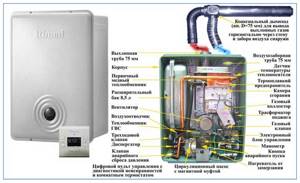
Rice. 14 Design of the Rinnai gas boiler
When choosing a boiler, the following tips may be useful:
- If there is no hot water supply in the house, it is rational and cheaper to choose a double-circuit boiler model than to install a separate single-circuit unit and a gas water heater, an electric boiler.
- When using electricity, the night tariff is much cheaper than the day tariff, in this case you can save on the cost of electricity. To do this, at night they warm up the entire house, with the exception of the bedrooms, and during the day they turn off the boiler for a long time or operate it in the minimum heating mode.
- For reliable operation of all boilers controlled by automation powered from the mains, you should purchase an electric generator with automatic switching on in case of power failure - this will allow the boiler equipment to continue operating in case of emergency situations on the power line.

Rice. 15 Construction of a Kolton solid fuel boiler
Features of the design of a heated floor connected to a boiler
When designing a floor heating system from a boiler, you need to take into account:
- the size of the pipeline and the number of branches, the longer the circuit, the slower the fluid circulation will be;
- power of the heating element - if the size of the lower threshold of the heated room corresponds to the power of the boiler, then after some time the efficiency of heating the coolant may decrease; the solution is to buy a heater with a power reserve of 20%.
In addition, the system requires constant maintenance - periodic descaling of the storage tank and heater. This procedure will help keep underfloor heating pipes in good condition and increase their service life.
It is recommended to connect the boiler in a bathtub or room located close to the heated room.
And to increase the productivity of the device, the structure must be equipped with a circulation pump.
By observing all of the above points, you can build a hydrofloor that can provide heating for your apartment.
Invisible moments of connection
In order for the structure to work fully, the following invisible points must be taken into account during design and connection:
- placement of an electric water heater - it is better that it is located fairly close to the heated room;
- difficulty of the heating circuit - the longer and more complex the pipe circuit, the very slowly water flows through it, therefore, heat loss increases;
- the power of an electric water heater should be 15-20% higher than the calculated energy consumption;
- In order to improve the operating efficiency of heated floors, it is recommended to connect a circular pump to the system.
At the same time, it will be necessary to provide for a very high load on the boiler. Because of this, he needs regular preventative care.
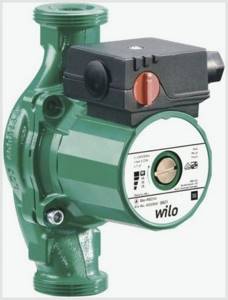
Circular pump
Making a heated floor from a heating electric water heater is not very difficult. It will be able to provide sufficient heating of the room, and the installation process of the system is the simplest. However, it is necessary to take into account the low power of such a device and count on heating small areas.
Connection diagrams for heated floors and boilers
There are several schemes for connecting a heated floor to an indirect water heater. Let's look at the simplest ones:
- Using a three-way valve - the essence lies in the interaction of two circuits: a warm floor and a water heater. This valve distributes the coolant between them. It is controlled automatically using a thermostat on the heater. This system promotes rapid heating of water in the boiler, while it is possible to completely shut off the supply of hot water to the floor branches. And when the set temperature is reached, the valve is activated and the supply is resumed. This piping method is suitable for constant use of the boiler.
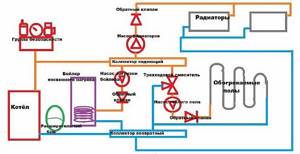
- With two forced circulation pumps - this option is recommended for intermittent, seasonal use of the device. One is placed on the supply pipe in front of the water heater, and the other on the floor contour.
A thermal relay is used to power the circulation pump, so it functions only when the temperature drops below normal. Heating accelerates, and forced circulation is turned on. In this scheme there is no three-way valve, and the connection is made using tees.

- Using a hydraulic arrow - this method is recommended for boilers with a volume of 200 liters or more, and with several heating branches. A system with a hydraulic distributor makes the circuit simpler, and there is no need to install pumps on each floor circuit. The hydraulic arrow ensures equal coolant pressure in all loops. However, it is difficult to make a harness with your own hands in this way without experience.
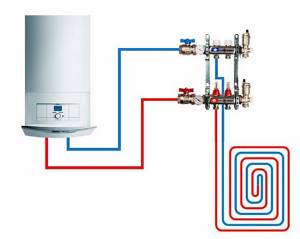
Filters
As you know, a filter is a necessary component of the water purification process.
As a rule, filtration systems are divided into fine or coarse filters and drinking water supply filters. Fine filters are installed in the pipe section after the mud trap and purify water from sludge using a stainless steel mesh with various cell sizes (in most cases, cells measuring 100 microns are used). Also, fine filters can be additionally equipped with a pressure reduction reducer, which allows you to control the pressure of purified water after the filter, thus protecting the mixers from water hammer and high pressure.
To supply drinking water, a reverse osmosis system is best suited, since during purification, water passes through the largest number of filter elements, namely three prefilters, a membrane and a postfilter. Reverse osmosis filters remove 99.9% of bacteria from drinking water, so you get pure water. In cases of moderate contamination or limited installation space, we may advise you to install a flow-through filter equipped with prefilters only.
Construction and connection of heated floors to the boiler
For clarity, let’s look at how to make a heated floor from a water heater, using the example of using a 3 kW heater to heat an area of 30 m2, with the installation of a three-way valve.
We will need a recirculating boiler with outlets to connect hoses for hot and cold water supply. The recommended diameter of the pipes is 2.6 centimeters. In addition, you should stock up on the tools that you will need in your work so as not to be distracted during the installation process.
The sequence of construction of hydrofloors from a water heater is as follows:
- Preparing the rough base - it should be leveled and cleared of debris.

- Installation of the collector unit - it must be mounted on the wall, or mounted in a specially equipped metal box.
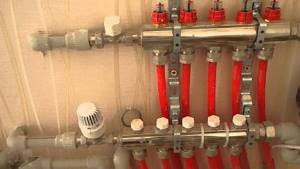
- Taping damper tape around the perimeter of the room will help maintain the integrity of the concrete screed.
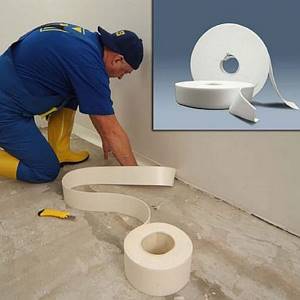
- Hydro and thermal insulation - polyethylene film can be used as a waterproofing material. The choice of thermal insulation material is huge, from ordinary polystyrene foam to polystyrene foam mats with bosses.

- Installation of the water circuit - these can be pipes made of copper, polyethylene or heat-resistant plastic. The heating elements are laid according to the planned pattern and with a set step. The pipes can be attached to the reinforcing mesh, which is laid on the thermal insulation, with plastic clamps, or fixed between the grooves of polystyrene plates.
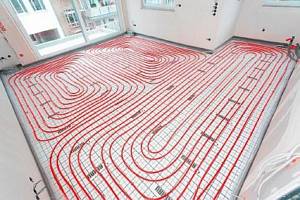
- Connect the circuit to the distribution manifold - one end to the cold tap, and the other to the hot one.

- The boiler is connected to the distribution unit using metal pipes.
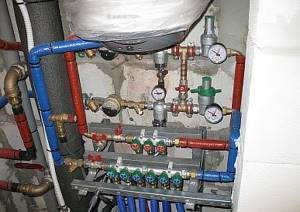
- Installation of a three-way valve with a thermal head on the manifold - to regulate the temperature level of a warm water floor.
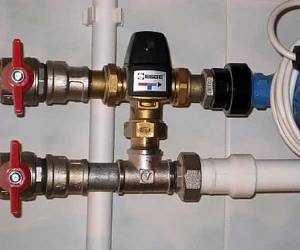
- Connecting a circulation pump to a warm floor - it provides the flow and necessary pressure of water in the floor pipeline.

- Installation of an expansion tank - it is necessary to remove excess water from the heating system. It should be mounted on a cold metal pipe near the outlet to the boiler. And in front of it you need to equip a tube for air outlet.
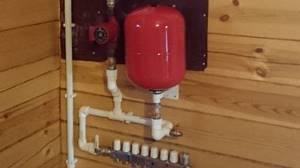
- Checking the system for operability - to identify possible leaks and malfunctions. Pressure testing is carried out during the day under operating pressure.

- Filling the screed - the contour of the floor is poured with concrete mortar. The procedure is done when there is pressure in the pipes. The concrete layer must be allowed to dry thoroughly, this will take about a month.

- Laying the finishing coating - it is laid only on a completely dry concrete base.

You can turn on the water system only when the screed, as well as the tile adhesive if ceramic tiles were used as a floor covering, have dried. The temperature should be raised to operating condition gradually over several days.

The principle of operation of this circuit is to heat water in the tank, then it is discharged through the collector into the floor circuit. The waste coolant is returned through the distribution unit to the return pipeline.
If the water temperature exceeds the required level, the three-way valve automatically shuts off the hot water supply and opens the cold water supply. The mixing process is carried out in a special chamber. When the coolant reaches the desired degree of heating, the thermal head closes the flow of cold water.
The heater and collector are equipped with separate automatic devices for temperature regulation. The device on the collector is responsible for the coolant in the floor line, and on the shade - for the level of water heating.
You can install a heated floor from a boiler both in a house and in an apartment. Installation is not difficult, the main thing is to follow the technological process and instructions. In addition, the low cost of installation is of no small importance, because a water heater costs less than an electric boiler.
However, it should be noted that the operation of such a heating system is accompanied by high energy consumption. Therefore, it’s up to you to decide how to heat your home - with a regular radiator or underfloor heating from a boiler.
Features of two-pipe circuit wiring
The two-pipe system comes in several varieties.
They have a different connection diagram for heating radiators in a private house, and a different vector of coolant movement. In small private houses, the following types of two-pipe heating systems are used:
- dead end;
- passing;
- collector (radial).
Brief characteristics of two-pipe systems
Collector is the most expensive heating distribution scheme for a private house due to the need to lay pipes to each battery, and their installation is hidden.
Open "gravity" two-pipe system
For successful operation of the “gravity” system, a slope of 3-5 mm/m is ensured during installation. Due to gravity, any type of heating system can operate if the necessary conditions are created - the slope of the coolant supply lines for natural circulation. It must be taken into account that the “gravity” system can only work with an open expansion tank.
Closed two-pipe system
And in order to install the heating of a two-story private house with your own hands, the wiring diagrams must contain the required number of liquid supply branches. One branch of the collector should power the batteries on the upper floor, the second branch should power the batteries on the lower floor. The water that has given up its heat returns to the boiler through the “return”. A closed system must have a circulation pump to create pressure.
Features of electric boilers
In terms of the degree of autonomy, one of the key criteria on which a boiler is selected, its electric version is in the lead, due to the absence of flammable substances. Having automatic settings, it does not require human intervention, automatically restoring the mode in cases of a short-term power outage. Its reliability, compactness, and affordable price are also attractive.
Installing a heated floor with such a boiler does not require expensive piping, thanks to the initial temperature of the water, which is the coolant, at 25°C. It is enough to mount a collector to connect several circuits.
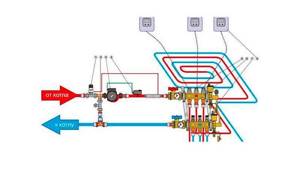
A modern electric boiler for a warm water floor has three varieties.
- Safe electric boilers operating on heating elements have already received recognition, as they have a fairly simple technical structure. The main weakness of this type of device is the short service life of the heaters, which is compensated by their low cost and simple replacement technology.
- Electrode boilers are a fairly new type of heating equipment, characterized by durability. Compared to the previous analogue, they are more capricious, since flawless operation requires a certain composition of the coolant, which must conduct current. This is due to the operating principle of such a boiler: between two electrodes under an alternating voltage of 50 Hz, placed in a liquid, the movement of ions begins, releasing heat. Positively charged particles move towards the cathode, and negatively charged ions move towards the anode. The electrodes change polarity 50 times per second, so heating occurs quickly.
- Induction models are based on heating a conductor placed in a magnetic field. The role of the core is played by the boiler body in the form of a labyrinth through which water flows. Such a device is reliable, requiring only monitoring of the constant presence of coolant in the system. The widespread use of induction boilers is limited by their high cost.
Environmentally friendly, not polluting the atmosphere of the house with combustion products, the electric boiler is convenient because it can be placed almost anywhere. The only difficulty may be the need for local wiring. Among the disadvantages, there is an increase in energy consumption (consumption per 30 cubic meters ≈ 1 kW/hour). In private households, where frequent power outages are possible, it is advisable to install a combined type, which provides the option of a backup boiler with solid fuel.
